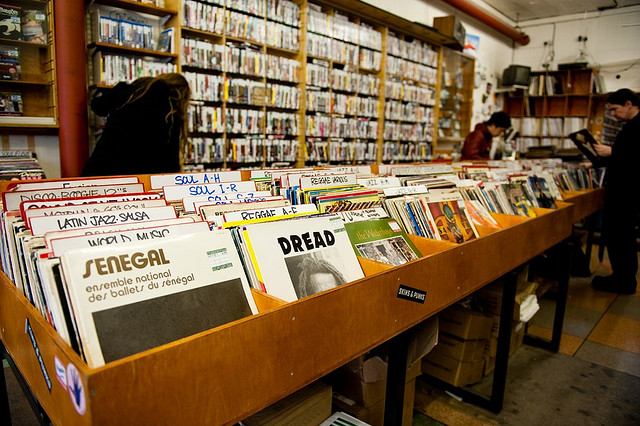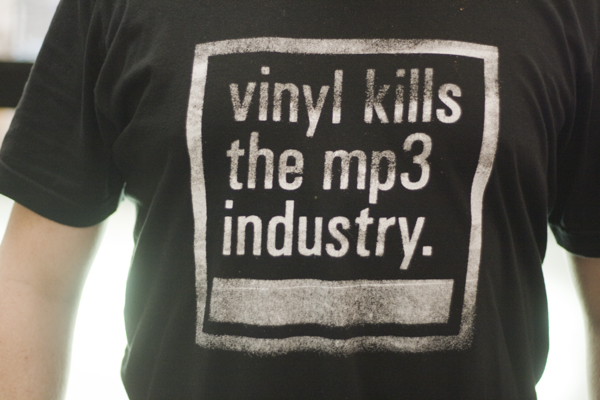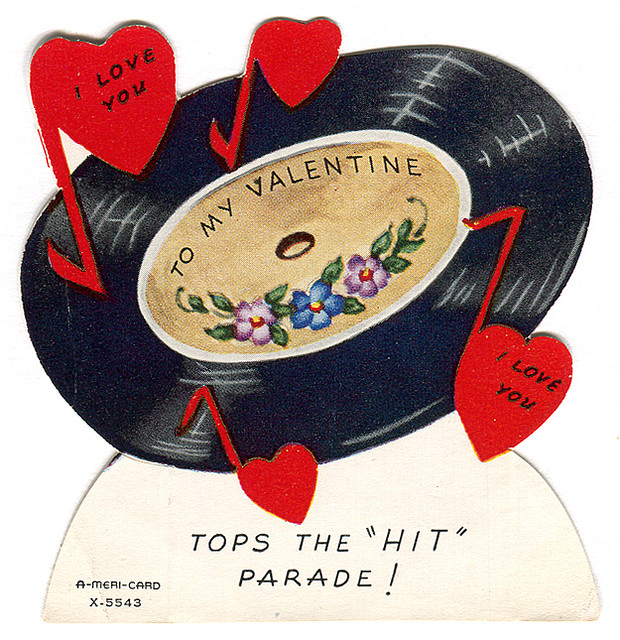At first, it seemed like it might be just a blip: amidst generally declining sales of physical music, down sharply from their 1990s boom, vinyl sales were trending up. The reversal started with a slight uptick in 2007 – already noticeable as the CD had begun its collapse. That slight uptick has turned into a small boom. From a tiny 300,000 units in US sales in 1993, the vinyl record is projected to do some 3.6 million units in sales. Source:
Vinyl Projected to Grow More Than 25 Percent In 2011…
Let’s put some of this in perspective. Even with explosive growth, vinyl remains at the margins, representing 1.6% of physical sales in the US. In fact, part of the fetish around vinyl is evidenced by the fact that people would make this headline news – fans of the vinyl record are understandably eager to hear their format of choice is doing well. As a point of comparison, in the last 30 days, just one independent band website, Bandcamp, has done US$640,513 in profit for its members. That’s profit, not revenue, and it’s often going directly to artists.
You can also, via Digital Music News, compare to vinyl’s years as the dominant format, which makes this all look very niche:
The Vinyl Comeback, In Historical Perspective…. (Thanks, JP in comments.) That graph doesn’t show per-unit cost, and anecdotally, artists seem closer to the record release process than they once were.
That said, vinyl’s significance in the new world order is arguably more about its cultural meaning than its numbers. (Getting away from numbers – cough, digital – is the point.) Cutting a vinyl record today is about making a physical artefact of a release. It carries with it prestige. Its scarcity is part of its value, with exclusive 12″ releases again returning to the days when DJs were judged by the obscure gems in their collection, not the disposable digital hits.
And I can see any number of benefits to vinyl’s reemergence:
- Bringing tactile back. Records as objects are a pleasure; I’m the last person to argue there. There’s a ritual to putting on a record that changes how you feel about the music, versus the seemingly-infinite, ephemeral digital jukebox.
- Keeping vinyl DJing alive. At this point, it seems more about preserving the record and mixing rather than scratching, but vinyl remains essential for people DJing with turntables. Notably, unlike faking it with digital control vinyl, using actual records is also more reliable – a slight flaw or vibration won’t bring the whole mix to a standstill. (Analog most definitely fails more gracefully than digital.) That makes the presence of vinyl releases doubly important to getting to hear traditional DJ technique.
- Keeping the cutters, and players, in business. The demand for vinyl records, whatever may motivate it, means everything from turntable repair to disk lathe shops remain healthy.
- The sound is unique. I’m leaving perhaps the most significant point for last. The sound of vinyl does remain unique, precisely because of some of its limitations, and I don’t think any amount of fetishization would please some of its consumers if it didn’t sound good.
When I spoke to Anika earlier this year, she brought up the economic point, too – that vinyl keeps things physical, and supports artists. Now, financially, it may be a tenuous point – look at those Bandcamp numbers – but “support” for artists is more than financials alone. And viewed in a larger effort to express the value of music in tangible form, vinyl makes sense.
Vinyl, incidentally, doesn’t have a monopoly on tangible music. Even digital has made various plays on the concept – one of the most unique being Ghostly International’s effort last year to produce “totems” for Matthew Dear, physical objects that represented the spirit of the intangible music.
Sound, above all, is cited as the primary rationalization for vinyl’s resurgence, but that’s where I feel a bit more conflicted:
- Mastering digital for vinyl isn’t the same as a “direct-to-analog” process. Here’s where things get weird. Remember in the early days of CDs, seeing the letters “DDD” and hearing about fully digital signal flow? Now, we have an oddly inverted situation. People are making music almost entirely inside computers, with software like Ableton Live, doing a digital master, and then printing the whole thing to … vinyl. There’s nothing to say that can’t work, but it seems to me a potential mismatch of source material and recording medium. (More on that in a moment.)
- Psuedo-science, go! Let’s face it: there’s plenty of voodoo around “digital,” and plenty of voodoo around “analog.” In the digital domain, the faux science tends to manifest itself as unsupported claims about the value of absurdly-high bit rates and sample rates, or, if you’re really unlucky, gold-plated digital interconnects. In analog, you’ll routinely hear people claim that analog captures “more” sound, because digital leaves “gaps” between samples, missing that both are constrained first and foremost by the transducers. Analog or digital, these are based on misunderstandings about fundamental characteristics of how sound is reproduced and heard from recording media. I think it’d be unfortunate if the genuine value of vinyl and the unique characteristics of its sound were obscured by claims about recording that simply aren’t true.
Vinyl itself is surely not to blame here; it should just raise some questions. Presumably, not all digitally-produced music really fits vinyl as a medium. And the right way to make that fit work is to really listen and apply some scientific understanding of the process.
Vinyl is that it is a unique medium, one with imperfect recording characteristics. That means whatever the source, you do need to mix differently, which makes a recent piece in Electronic Musician very admirable, indeed. (Disclosure: I have never mixed and mastered for vinyl, so I can only look upon this as an enthusiastic listener and interested observer. I welcome feedback from those out there who are more qualified to investigate the questions I’m asking.)
Learn Mixing | Tips for Mixing for Vinyl [Electronic Musician]
Gino Robair, one of my favorite EM writers over the years, goes through some detail about preparing mixes for vinyl as the delivery medium. Part of what you’ll find is a reminder of why engineers were excited about digital in the first place: there’s a greater ability in digital recordings to capture certain details of the high and low end that would distort in an analog recording. So long as you go into the reality of these limitations with your eyes (or make that ears) open, it can be a good experience as a producer, and for your listeners.
This raises still more scientific and perceptual questions, though. I’m not entirely convinced – I haven’t seen evidence in either direction – that it’s in any way necessary to use a 24-bit, 96kHz master for a vinyl release. (Gino points to the example of Arcade Fire using that as the master.) It certainly can’t hurt, especially in the era of cheap storage. But as in direct-digital delivery, the question is whether you really gain from the higher-resolution file. The only way to know for sure would be to do lab-style experimentation and find out, and as readers have lamented on this site before, there’s not a whole lot of that going on.
Vinyl’s good; vinyl’s unique. (So, too, are cassette tapes and other media with which music producers have been re-discovering of late.) It just means that any claims about vinyl’s resurgence should be scaled against the growth of other distribution outlets, and that we should ask honest questions about sound, not just accept either digital or analog claims of “quality” without evaluation.
So, I purposely raise the points above more as a question than a statement. I’m curious to hear from people who are producing and consuming vinyl records, in terms of what they’ve found satisfying and what they’ve found disappointing. (I mean that, in particular, in regards to certain releases – I’m sure some are better than others.)
And I also wonder whether it’s possible to begin to appreciate digital recording with foresight as much as it is vinyl with hindsight. How can we make the most of the format we have today? How can we understand it, in virtual form, as physical object?
At the end of the day, “analog” is not real. (Hence the name.) A recording is an artificial and imperfect snapshot of an event that occurred in the past, frozen in time in an impossible way. It’s what is beautiful about recording, and what terrified, or at least confused, some of those who first heard it. It is a technology conceived as a precursor to email, as a kind of business memo. It has become to many what music is, rather than the reflection of musical performance. It has had a devastating impact on many forms of live performance, emptying bandstands and causing live players their livelihood before anyone became concerned about whether the record industry that was left would lose its financial well-being.
The “record,” whether it’s a cassette tape or a FLAC download, is strange and unnatural, with the ability to bring to life dead musicians and performances that never existed in one place.
And yes, we do really love it.


